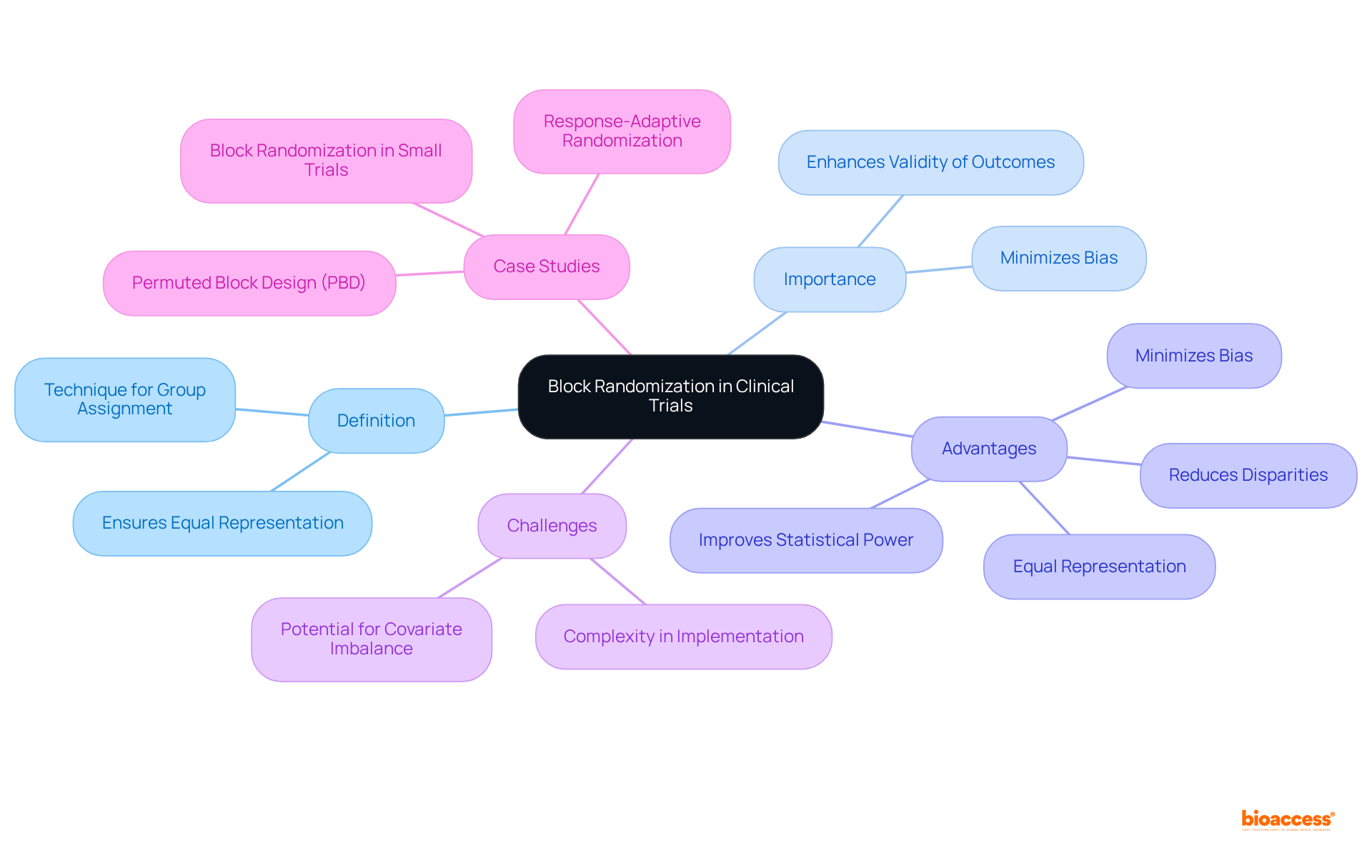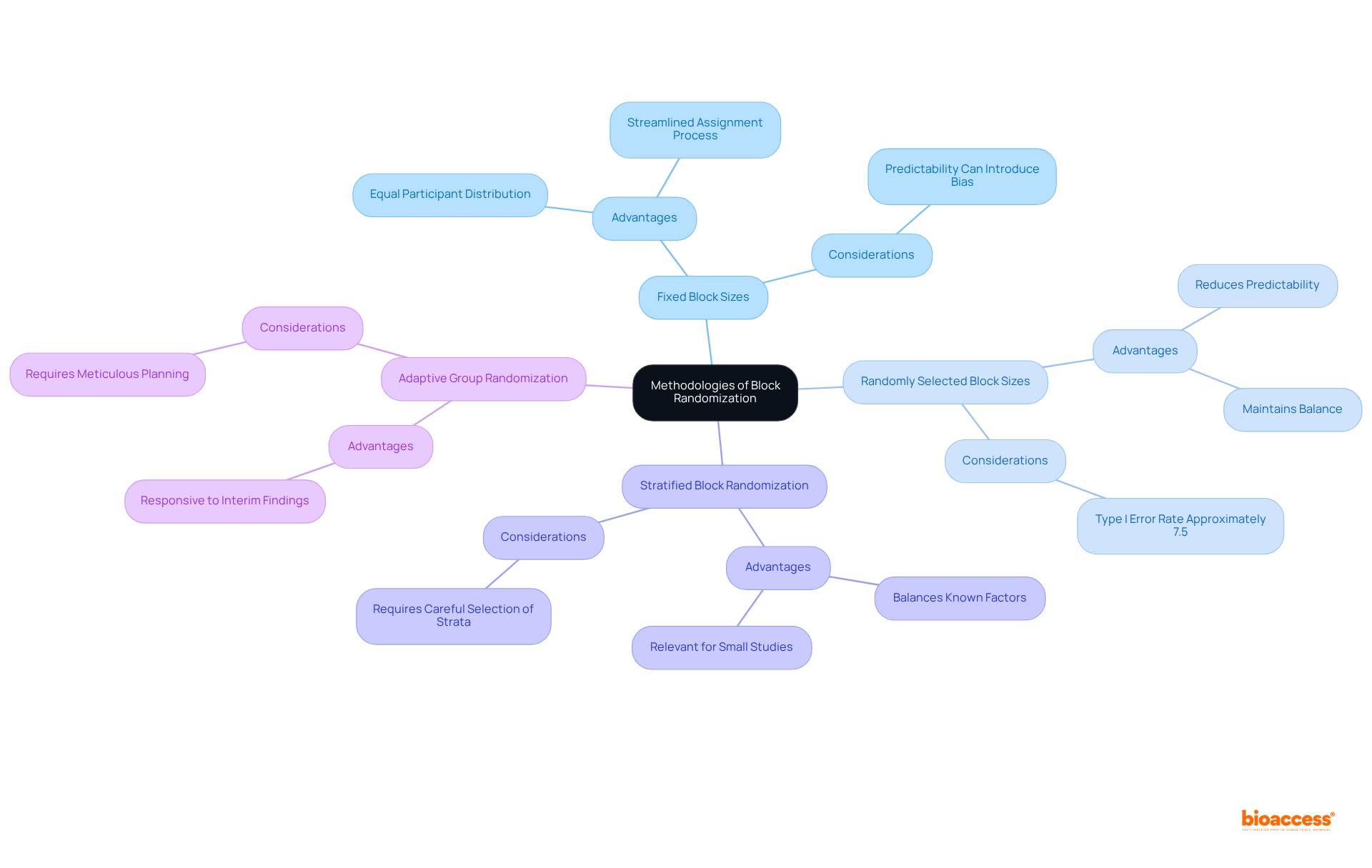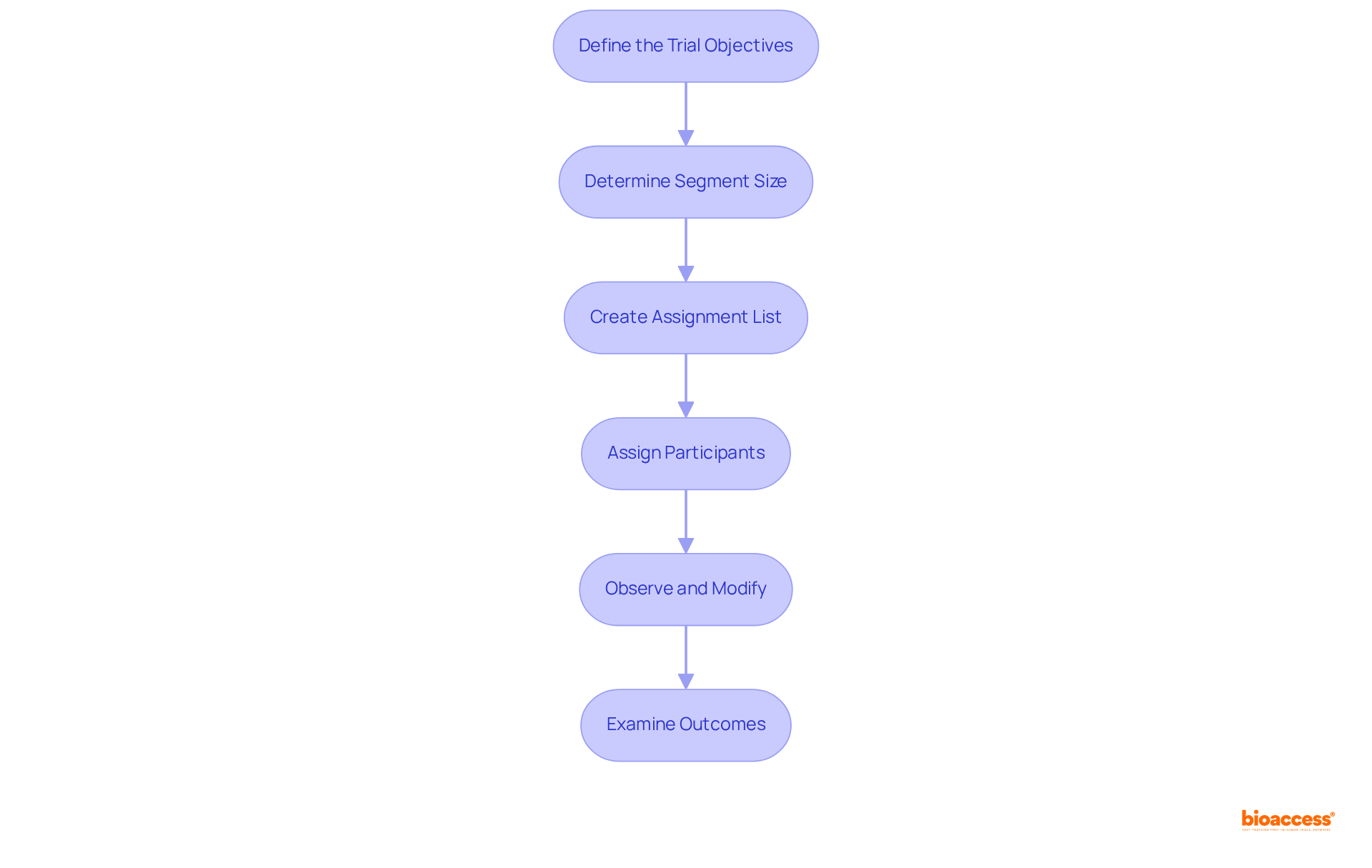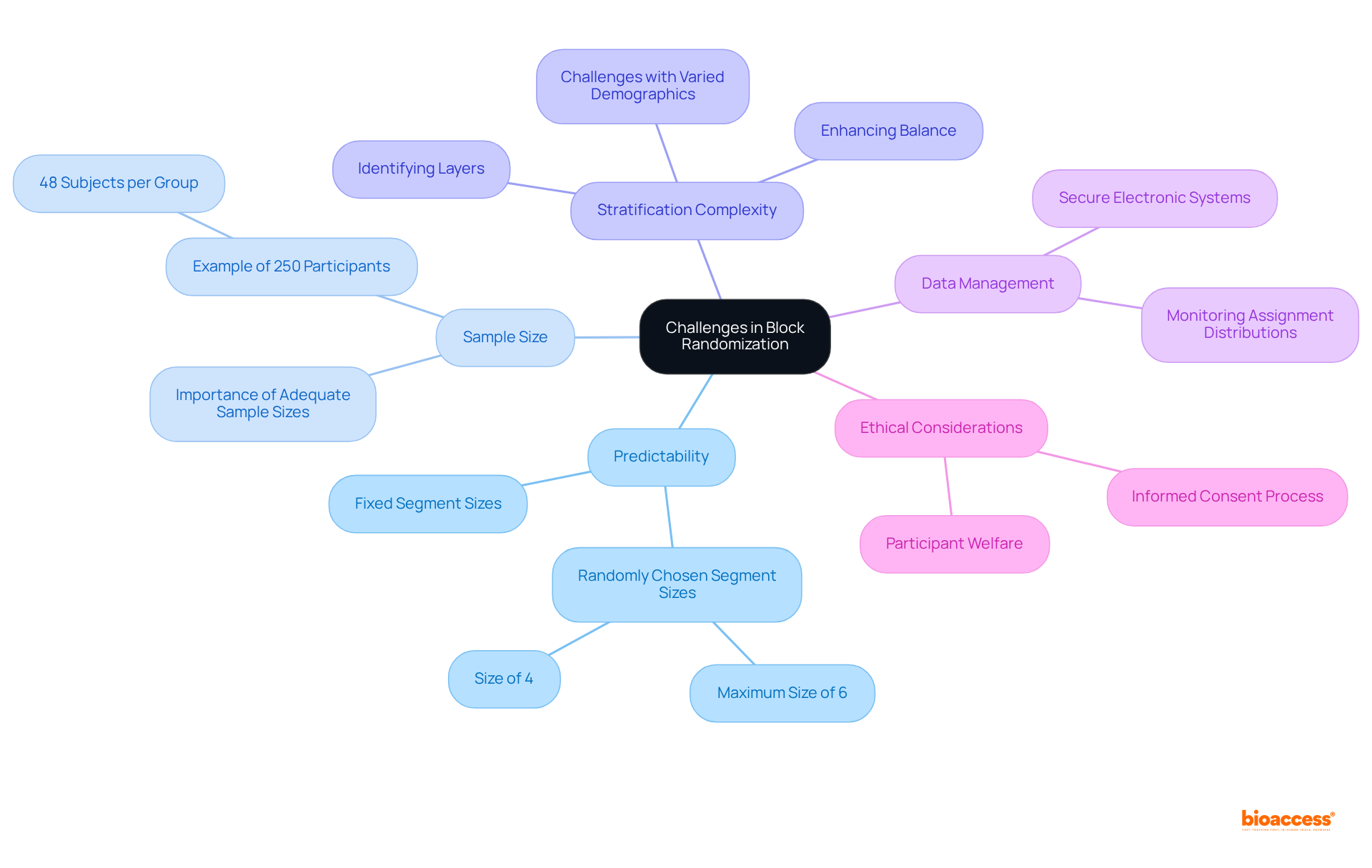


Block randomization stands as a pivotal technique in clinical trials, ensuring equal representation across intervention groups. This approach not only minimizes bias but also significantly enhances the validity of study outcomes. By implementing methodologies such as:
Researchers are equipped to maintain balance among groups. This balance is essential for the accurate evaluation of intervention effects, ultimately contributing to the integrity of clinical research.
Block randomization serves as a cornerstone in the architecture of clinical trials, ensuring that participant allocation is both fair and unbiased. This method not only enhances the reliability of study outcomes but also addresses the critical need for balance among intervention groups, particularly in smaller studies where disparities can skew results.
As researchers delve into the intricacies of block randomization, they often encounter challenges that raise important questions about its implementation.
Block allocation is a pivotal technique in clinical studies, ensuring participants are assigned to intervention groups in a manner that guarantees equal representation across these groups. This method involves dividing participants into groups of a predetermined size, with each group containing a specific number of assignments. The significance of block randomization is its capacity to minimize bias and maintain equilibrium in group allocation, which is crucial for the validity of study outcomes. By ensuring that each participant group comprises a similar number of individuals, researchers can evaluate the effects of the interventions more accurately.
This approach proves particularly advantageous in smaller studies, where block randomization can help address random variations that lead to substantial disparities in group sizes, potentially distorting outcomes and interpretations. For instance, in a study with 40 participants, employing a randomized grouping method can yield equal representation, resulting in 20 participants in both control and treatment groups. Furthermore, with larger sample sizes, such as 200 subjects, the likelihood of imbalance diminishes to 15.7%, underscoring the efficiency of grouped assignment in maintaining balance.
The permuted block design (PBD) stands out as the most commonly utilized method of allocation in clinical studies, highlighting the significance of block randomization in ensuring grouped arrangements. Case studies have demonstrated that grouped allocation significantly reduces the likelihood of baseline disparities, thereby enhancing the credibility of trial results. However, it is crucial to acknowledge that while random grouping can achieve equilibrium in sample sizes, it may still lead to disparities in covariates, potentially introducing bias and affecting the study's outcomes.
Overall, the implementation of grouping techniques not only bolsters the reliability of clinical evidence but also promotes equity by affording each participant an equal opportunity for assignment. As Brian G. Ragan aptly states, "random assignment is viewed as the gold standard in most clinical trials," highlighting the indispensable role of techniques such as grouped assignment.

Block allocation can be implemented through various methodologies, each offering distinct advantages and considerations crucial to clinical research. Key approaches include:
Fixed Block Sizes: This method employs blocks of a predetermined size, ensuring equal participant distribution across intervention groups. While it streamlines the assignment process, it can result in predictability in allocations, potentially introducing bias. As noted by Jimmy Efird from the Center for Health Disparities Research, "The goal of randomization is to attain equilibrium regarding known and unknown risk factors in the distribution of participants to intervention groups in a study."
Randomly Selected Block Sizes: To counteract predictability, researchers can employ blocks of varying sizes, randomly determining the size for each block. This technique preserves balance while reducing the risk of bias in resource allocation. The type I error rate for random designs, such as the Randomized Block Design (RBD), is approximately 7.5%, underscoring its effectiveness in maintaining statistical integrity.
Stratified Block Randomization: Participants are grouped into strata according to specific traits (e.g., age, gender) prior to random assignment. Within each stratum, block randomization is then applied, ensuring balanced groups overall and also within critical subgroups. This method is particularly relevant for small studies where results may be influenced by recognized clinical factors.
Adaptive Group Randomization: This versatile approach allows for modifications in group sizes or treatment assignments based on interim findings. While it enhances the responsiveness of the proceedings to emerging data, it necessitates meticulous planning and monitoring to uphold integrity. The permuted framework design (PFD) is the most commonly employed method of allocation in clinical experiments, providing a robust structure for achieving equilibrium while minimizing selection bias.
Each methodology presents distinct factors, and the choice should align with the study's goals and structure. For instance, fixed segment sizes can simplify analysis but may compromise unpredictability integrity, whereas variable segment sizes enhance unpredictability, thereby reducing selection bias. The method selected is critical for attaining reliable and valid results in clinical research.

Implementing block randomization in clinical research is a process that involves several critical steps, which are supported by the comprehensive clinical trial management services provided by bioaccess.
Define the Trial Objectives: Clearly outline the goals of the clinical trial, including both primary and secondary endpoints. This clarity is essential for guiding the randomization process and ensuring alignment with overall research aims.
Determine Segment Size: Decide on the segment size based on the total number of participants, which should be at least 234 to maintain sufficient statistical power, and the desired balance between intervention groups. Employing randomly chosen segment sizes can improve unpredictability and decrease bias in assignment allocation.
Create Assignment List: Develop a list that specifies treatment assignments for each block. This can be achieved using statistical software or random number generators, ensuring true randomness and adherence to the trial design. Furthermore, creating a dummy allocation schedule can assist stakeholders in previewing final outputs while preserving blinding.
Assign Participants: As individuals are recruited, allocate them to intervention groups based on the allocation list. It is essential to hide the allocation process to avoid bias and uphold the integrity of the experiment. Maintaining confidentiality of allocation data is also essential for preserving treatment blinding.
Observe and Modify: Throughout the experiment, continuously oversee participant distribution to ensure adherence to the allocation protocol. Be prepared to make adjustments if necessary, especially when employing adaptive methodologies that may require real-time changes. Adhering to ICH E6(R2) guidelines on good clinical practice is crucial during this phase. bioaccess provides project management and monitoring services to support this process effectively, along with feasibility studies and compliance reviews to ensure all regulatory requirements are met.
Examine Outcomes: Once the experiment ends, evaluate the data while considering the method of allocation applied. This analysis should encompass checks for balance between groups and any possible biases introduced during the experiment, ensuring robust statistical validity.
By carefully adhering to these procedures and utilizing the knowledge of bioaccess in study setup, compliance assessments, and reporting, researchers can effectively execute block randomization, greatly improving the reliability and validity of their clinical studies. This method has been shown to improve success rates in various clinical trials, making it a preferred choice for many researchers.

Block randomization serves as a robust method for ensuring balanced treatment assignments, yet it presents several challenges that researchers must navigate:
Predictability: Utilizing fixed segment sizes can lead to predictability in treatment assignments, potentially introducing bias. To counter this, researchers should contemplate using randomly chosen segment sizes, such as a maximum size of 6 or a size of 4, which can obscure patterns and improve the integrity of the process.
Sample Size: The effectiveness of block allocation is heavily influenced by the total sample size. Inadequate sample sizes can lead to imbalances that weaken the benefits of random assignment. For instance, a planned enrollment of 250 participants in a two-armed trial, with 48 subjects per group, underscores the importance of sufficient sample sizes to ensure balance across groups.
Stratification Complexity: While stratified block allocation can enhance balance among treatment groups, it introduces additional complexity. Researchers must carefully identify the number of layers and ensure that each layer is sufficiently populated to enable effective sampling. This complexity can be especially challenging in studies with varied patient demographics, as demonstrated in case analyses on stratified sampling.
Data Management: Precise monitoring of assignment distributions and participant allocations is essential. Establishing robust data management methods, including secure electronic systems for scheduling, is crucial to avoid mistakes and guarantee compliance with the protocol, thus protecting the trial's integrity.
Ethical Considerations: Ethical vigilance is paramount. Researchers must ensure that the allocation process does not compromise participant welfare or the informed consent procedure. This encompasses being clear about the selection method and its effects on participants, especially considering ethical issues related to the process before informed consent.
By proactively addressing these challenges, researchers can significantly enhance the effectiveness of block randomization in clinical trials, which leads to more reliable and valid outcomes.

Block randomization stands as a pivotal technique in clinical trials, ensuring fair and balanced allocation of participants across intervention groups. This method significantly mitigates bias, thereby enhancing the validity of study outcomes. The necessity of maintaining equilibrium in participant distribution is paramount, as it directly influences the reliability of results and the overall integrity of clinical research.
This article has explored various methodologies for implementing block randomization, shedding light on the advantages and challenges inherent to each approach. From fixed block sizes to adaptive group randomization, each technique presents unique benefits, alongside potential pitfalls that require careful management. Selecting an appropriate method based on the study's objectives and participant demographics is crucial for achieving reliable results.
Reflecting on the broader implications of block randomization reveals that addressing its challenges is vital for advancing clinical research. By prioritizing ethical considerations, ensuring adequate sample sizes, and employing effective data management strategies, researchers can optimize trial designs. Ultimately, mastering block randomization not only enhances the credibility of clinical findings but also promotes a more equitable approach to participant assignment, reinforcing the commitment to high-quality research in the medical field.
What is block randomization in clinical trials?
Block randomization is a technique used in clinical studies to assign participants to intervention groups in a way that ensures equal representation across these groups. It involves dividing participants into groups of a predetermined size, with each group containing a specific number of assignments.
Why is block randomization important?
Block randomization is important because it minimizes bias and maintains equilibrium in group allocation, which is crucial for the validity of study outcomes. By ensuring that each participant group has a similar number of individuals, researchers can evaluate the effects of the interventions more accurately.
How does block randomization benefit smaller studies?
In smaller studies, block randomization helps address random variations that can lead to significant disparities in group sizes, which could distort outcomes and interpretations. For example, in a study with 40 participants, it can ensure equal representation in control and treatment groups.
What is the impact of larger sample sizes on block randomization?
With larger sample sizes, such as 200 subjects, the likelihood of imbalance in group sizes diminishes to 15.7%, demonstrating the efficiency of block randomization in maintaining balance among groups.
What is the permuted block design (PBD)?
The permuted block design (PBD) is the most commonly utilized method of allocation in clinical studies, emphasizing the significance of block randomization in ensuring grouped arrangements.
How does block randomization affect baseline disparities in clinical trials?
Grouped allocation through block randomization significantly reduces the likelihood of baseline disparities, thereby enhancing the credibility of trial results. However, it may still lead to disparities in covariates, potentially introducing bias and affecting study outcomes.
What is the overall benefit of implementing grouping techniques in clinical trials?
The implementation of grouping techniques bolsters the reliability of clinical evidence and promotes equity by providing each participant an equal opportunity for assignment, which is essential for the integrity of clinical trials.